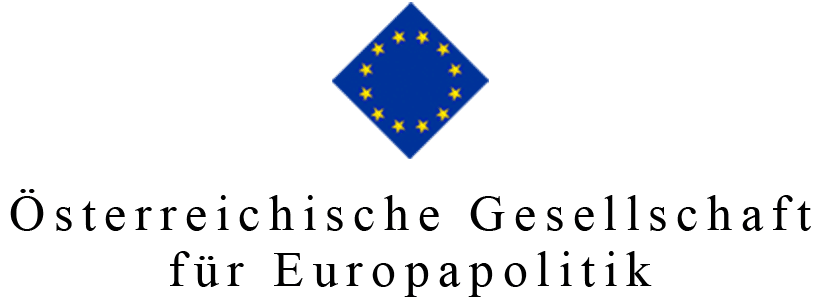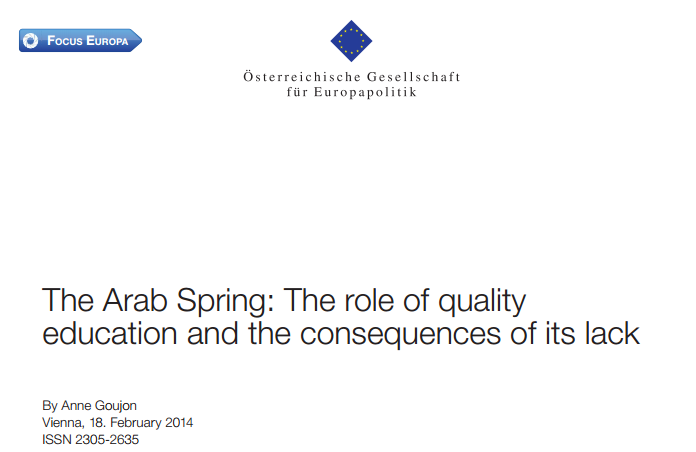The role of quality education and the consequences of its lack
Policy Recommendations
- EU Member States should increase bilateral cooperation for teacher training with Arab Spring Countries
- Focus on transparency and accountability in teachers training
- Promote the role of the EU as an umbrella and catalyst for all aid-driven education system reforms activities
Abstract
The lack of quality education plays a major role in explaining the Arab Spring: As a result of past shortfalls in education, large shares of the working-age population in the Arab-Spring countries do not have the right qualifications for entering the labour market. This not only leads to high levels of unemployment but also entails poverty and social distress. At the macro level, it triggers a vicious cycle of underdevelopment by hampering an upgrade to economies driven by knowledge and innovation despite the substantial numbers of higher educated citizens of working age in these countries. This holds particularly true for Egypt. Remedying the current lack of quality education should be a top priority in the countries of North Africa, because it is the source of many deficiencies plaguing this region. In the Arab-Spring countries, the European Union’s sectoral aid given for education has focused on quantity (e.g. raising enrolment by supporting the implementation of the Millennium Development Goals for Education) rather than on quality, where interventions usually target higher education (mostly through individual sponsorship programmes), although there are challenges at all levels, starting with basic education. The European Union’s main priority should be to guide and assist these countries in developing training programmes for teachers as the driving force behind the entire system reform.
***************************************************
The approach
I approach the topic as a demographer working in the fields of education and human capital. This means that, in addition to items related to age, sex and the demographic behaviour of populations typically analysed by demographers, I also study the educational attainment of these populations from both a historical and prospective viewpoint. In the course of my research career, I did several single and co-authored studies of this kind on the Middle East and North Africa (Goujon 1997, Goujon & K.C. 2010, Yousif & Goujon & Lutz 1996, Goujon 2002, Goujon & Barakat 2010, Goujon & Alkitkat 2010). The ideas for this paper were developed in the framework of the Diplomatic Academy Student Initiative (DASI) conference held in Vienna on 25 January 2013.
Education is the key
From a demographic point of view, North Africa has been a fascinating region ever since the demographic transition. The transition from high to low fertility and mortality regimes started quite late, generating high population growth. Initially, the research focus was on fertility and Arabs’ apparently high fertility patterns, which were often attributed to the dominant religion: Islam (see Makhlouf Obermeyer (1992) for a critical review of the evidence). Meanwhile, we know that there is no Arab fertility pattern. Unlike other countries in transition, the MENA region (Middle East and North Africa) simply followed a different fertility path, which was determined by such other factors as the existence of an oil economy, the colonial past, education, and most of all, women’s levels of educational attainment. In the same way, I would argue that there is nothing Arab-specific about the revolution which started in Tunisia in 2010 and rather emphasize the role of education as a fundamental trigger of the Arab Spring. As a consequence, investments in education should be a natural outcome in the post-Arab-Spring period.[1] This is where the EU should get involved and help North African countries create the instruments that go beyond initiatives promoting higher education (such as Erasmus Mundus or Edulink) and will give North Africans full access to quality education. The objective is to fuel a virtuous cycle in which a knowledge society fosters socio-economic development. In the absence of education, social and economic underdevelopment will prevail. The main point is that education works like a funnel whereas it should work like a pipeline. In fact, this metaphor used by US Vice President Joe Biden in 2011[2] to describe the situation in the United States is even more pertinent for North African countries and for the type of assistance they would benefit from. Their education systems need support throughout the entire educational cycle and not only at the higher levels.
In which way is education underdeveloped in North Africa?
Let us first take a look at the educational development in three North African countries: Egypt, Morocco and Tunisia. We can do so by studying education flows (enrolment) or education stocks (educational attainment of the population out of school). The former directly entails the later, albeit with a time lag. We shall first analyse some indicators of the educational levels attained by the adult population, which largely reflect important aspects of human capital. In Morocco, investments in education were very low for many decades after the country had become independent in 1956.[3] As a result, in 2009, the share of literates hovered around 50% for the whole population (56%) and was 44% among women aged 15 years and above (UNESCO[4]). Beside low levels of education, Morocco not only faces high youth unemployment, even among educated youngsters, but also shortages of skilled labour in several sectors. This mismatch will be amplified by the growing number of new entrants into the labour market in the next few years. The situation is very similar in Egypt where society is divided into a very highly educated (about half of the population of working age has completed at least secondary education[5]) and a very low educated part. Though in different ways, both pull the country’s development down as the poorly educated do not permit Egypt to embark on a different socio-economic path and the highly educated lack the appropriate skills despite their upper secondary or even higher education: another mismatch. In Tunisia, the provision of education was more successful: even though 22% of the 15+ population were illiterate in 2008, the new generation (15-24) has received sufficient schooling to become literate (according to UNESCO only 3% in this group are analphabets) and a large part of the working-age population has completed at least upper-secondary education. In Tunisia, the education problem is of a different type: There, the revolution is due to a well-educated society’s unmet high demand for democratisation and less corruption.
Another feature of the education system is that female education was neglected in most countries. In 2010, more than 60% of the female population of Egypt had less than primary education. As a result, 90% of the working-age women were not in Egypt’s (formal) labour force. In Morocco, this holds true for more than 70%. The rates for Tunisia are lower, yet more than 40% of the female population have completed less than primary education.
However, and most importantly, the percentages of educational attainment are not necessarily indicative as the education offered at all levels is not always of good quality. Teaching techniques are rigid, based on learning by heart and corporal punishment. Moreover, UNICEF, the United Nations Children’s Fund, notes that the school infrastructure is deficient: in Egypt, for example, 20% of all schools do not have proper toilets.
The need for reforms and EU involvement
Another interpretation is that the Arab Spring was not fuelled by the anger of well-educated but rather by the dissatisfaction of poorly educated youth “whose knowledge and skills do not meet the demands of a rapidly-advancing world” (Adams & Winthrop 2011). If the Arab spring is to have any lasting impact, it should therefore lead to education, and education reforms should crown the post-revolution period in the Arab world, as explained in the 2012 Arab knowledge report (MRBF[6] & UNDP[7] 2012).
So far, both national and international entities have mainly focused their reform efforts on the quantitative aspect of education by building more schools, training more teachers and enrolling more students. However, the issue of quality is more pressing. First and foremost, quality teacher training is essential for improving the test scores of students in all subjects taught in school but particularly in mathematics and science. Curricula and ways of imparting knowledge are decisive elements. How can students be familiarised with citizenship (not necessarily docile) and innovation and, more importantly, how can the skill mismatch between what is required for the new economic path and what is taught in schools and universities in the Arab-Spring countries be resolved?
Although Europe 2020 mentions objectives in the field of education, employment and social cohesion, particularly as a remedy against youth unemployment, the EU is rather conspicuous by its absence in this area. EU involvement currently concentrates on higher education programmes (mainly Erasmus Mundus, Edulink, Tempus), which are excellent but not sufficient, primarily because they operate at the individual level and have little impact on the development of higher education on the national level. Rather than improving the quality of instruction given to single individuals, it is more important for the Arab-Spring countries to develop their systems so they can offer better conditions to all students and teachers and that with the full support of the EU and its member countries.
The EU’s other main field of action in terms of human capital development is the prioritisation of the MDGs (Millennium Development Goals) at the global level. However, also in this area, quantity has been given preference over quality. The National Indicative Programmes[8]are too general to be truly effective and tend to leave the responsibility for promoting the necessary reforms to other organisations (UNDP, World Bank).
The EU’s involvement in promoting quality education in the Arab-Spring countries is essential and should take the form of partnerships, which could be bilateral in nature and involve more than purely financial support. This is one of the preferred types of co-operation between Morocco, Tunisia, Egypt and the European Union. Introduced in 2007, the European Neighbourhood and Partnership Instrument (ENPI) also covers countries of North Africa. Among other aims, it wants to support democratic transition and promote human rights. It is structured around strengthened dialogue on priority multi-sector reforms, also in terms of institutional support. Within the ENPI, the Twinning instrument brings together public sector expertise from EU Member States and beneficiary countries to enhance co-operative activities, and hence gives the EU the mandate and the tool to tackle some of the issues related to the development of quality education. However, the EU has not yet targeted the education systems of North African countries, but only supported quality insurance in high education in Egypt.[9]
In the period 2009-2012, the Moroccan government (primarily the Ministry of National Education of Morocco) initiated the Moroccan National Education Emergency Support Programme (3 Euro billion). It was supported by its development partners (World Bank, African Development Bank and the European Commission, which contributed 4% of the overall budget).[10] One prime goal of this programme was to overhaul the teacher training system by improving the initial training of teachers and offering teachers in place the possibility of continuing training. The programme has not yet been evaluated, but seems to have initiated some important actions and discussions at the national and local level. Such initiatives deserve support.
Train the teachers
What is the main concern today? Quality teacher training provided in order to develop the entire teaching profession must definitely be on top of the agenda for cooperation. Hence the EU should support the Arab Spring countries in combining social and human resources, improving the training of teachers and monitoring their post-training, but also by strengthening teachers’ accountability to make the entire school system more transparent.[11] Other important elements comprise enabling collaborations and professional exchange. The EU should suggest and compare strategies for improving teacher qualifications and empowerment in collaboration with the ministries of education. It could also play an important role in pulling together all initiatives from other donor agencies.
Inadequate access to relevant quality education is at the heart of the challenges facing most North African societies in the post-Arab-Spring era. If the EU intends to facilitate transitions, especially in the countries of the Mediterranean, it should actively support the quality of instruction provided by teachers in North Africa. The problem is that both education and demography only have an impact on human capital and the economy in the long run. A cynic would take this to indicate that not much is to be gained from investing in education and hence try other strategies. However, there is no way around education and the fact that these reforms take a long time should rather prompt governments and international bodies such as the EU and its member countries to act immediately, not least in view of education’ spillover effects such as lower population growth, declining mortality and morbidity, the spread of democratic ideas and peace.
1) Please note that I did not say that education was the cause of the Arab Spring. Although education is a good explanation, no explanatory models at the individual or macro level can rely on one single factor.
2) all4ed.org/moving-from-an-education-funnel-to-a-pipeline/ [consulted on October 23, 2013].
3) It goes without saying that the development of the education sector was even less privileged during colonial times.
4) See UNESCO (United Nations Educational, Scientific and Cultural Organization) database of country profiles on education: stats.uis.unesco.org/unesco/TableViewer/document.aspx [consulted on 11 December 2013].
5) According to the 2006 Census (Central Agency for Public Mobilization and Statistics).
6) Mohammed Bin Rashid Al Maktoum Foundation
7) United Nations Development Programme
8) In the Development and Cooperation Programme (EuropeAid) of the EU, the National Indicative Programmes define the strategic axes of co-operation between the EU and the cooperation countries, which are also detailed in the Country Strategy Paper.
9) See: ec.europa.eu/europeaid/where/neighbourhood/overview/documents/neighbourhood_twinning_news_26_en.pdf [consulted on 23/10/2013].
10) Other international agencies contributed a total of 12% of the overall programme budget.
11) Including financial transparency: for instance, 60% of all Moroccans consider the education system to be corrupt or highly corrupt (Transparency International 2013).
- Adams, A. and R. Winthrop. 2011. The role of education in the Arab world. Brookings Global Compact on Learning Report number 2.
- Goujon, A. 1997. Population and education Prospects in the Western Mediterranean Region. IIASA Interim Report IR-97-046. Laxenburg, Austria: IIASA.
- Goujon, A. 2002. Population and education prospects in the Arab Region. In: I. Sirageldin (ed.), Human capital: Population Economics in the Middle East. Cairo: The American University in Cairo Press, An Economic Research Forum Edition: 116-140.
- Goujon, A. and B. Barakat. 2010. Future demographic challenges in the Arab world. The Emirates Occasional Papers No. 75. Dubai: Emirates Center for Strategic Studies and Research.
- Goujon, A. and H. Alkitkat. 2010. Population et capital humain en Egypte à l’horizon 2050 [Population and human capital in Egypt up to 2050]. In: P. Blanc (ed.), Egypte: l’Eclipse, Confluences Méditerranée, numéro 75, Automne 2010: 33–48. Paris: L’Harmattan.
- Goujon, A., S. K.C. 2010. Gender gap handicap in North Africa. Options (IIASA, Laxenburg, Austria), Summer 2010, p.22.
- Makhlouf Obermeyer, C. 1992. Islam, Women, and Politics: The Demography of Arab Countries. Population and Development Review 18 (1): 33-60.
- MRBF and UNDP. 2012. Arab Knowledge Report 2010/2011: Preparing Future Generations for the Knowledge Society. Dubai, United Arab Emirates: Mohammed Bin Rashid Al Maktoum Foundation (MBRF) and the United Nations Development Programme / Regional Bureau for Arab States (UNDP/RBAS).
- Transparency International. 2013. Transparency International’s ‘Global Corruption Barometer 2013’.
- Yousif, H. M., A. Goujon and W. Lutz. 1996. Future Population and Education Trends in the Countries of North Africa. Research Report RR-96-11. Laxenburg, Austria: IIASA.
ISSN 2305-2635
The views expressed in this publication are those of the authors and not necessarily those of the Austrian Society of European Politics or the organisation for which the author works.
Citation
Goujon, A. (2014). The Arab Spring: The role of quality education and the consequences of its lack. Wien. ÖGfE Policy Brief, 2’2014







